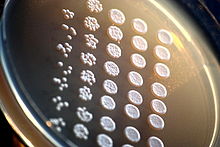A viability assay is an assay that is created to determine the ability of organs, cells or tissues to maintain or recover a state of survival. Viability can be distinguished from the all-or-nothing states of life and death by the use of a quantifiable index that ranges between the integers of 0 and 1 or, if more easily understood, the range of 0% and 100%.[2] Viability can be observed through the physical properties of cells, tissues, and organs. Some of these include mechanical activity, motility, such as with spermatozoa and granulocytes, the contraction of muscle tissue or cells, mitotic activity in cellular functions, and more.[2] Viability assays provide a more precise basis for measurement of an organism's level of vitality.
Viability assays can lead to more findings than the difference of living versus nonliving. These techniques can be used to assess the success of cell culture techniques, cryopreservation techniques, the toxicity of substances, or the effectiveness of substances in mitigating effects of toxic substances.[3]
https://en.wikipedia.org/wiki/Viability_assay

No comments:
Post a Comment